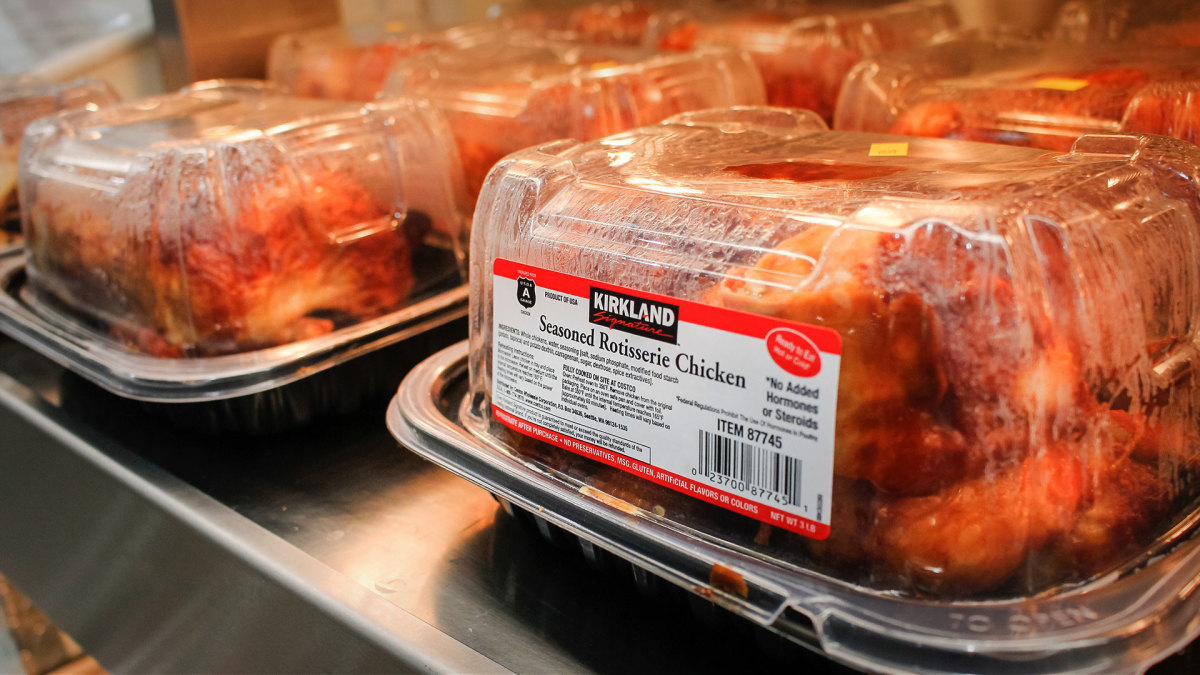
Paul Sakuma/AP
Vandana Ravikumar
Fri, June 17, 2022
Two Costco shareholders sued the company, saying that it mistreats and neglects the chickens used for its low-priced rotisserie chickens.
The complaint, filed by the organization Legal Impact for Chickens on behalf of shareholders Krystil Smith and Tyler Lobdell, accuses Costco of violating animal welfare laws in order to “supply itself with a large quantity of cheap chicken meat.”
Costco did not immediately respond to a request for comment from McClatchy News.
Costco sells its cooked rotisserie chickens for $4.99 each, a “widely-known and prominent feature” of its business model to lure customers into stores, according to the lawsuit. In order to maintain a constant supply of chickens and not raise prices, the company “knowingly propagates chickens that are bred to grow so fast that many of them cannot stand under their own weight,” the complaint says.
The lawsuit accuses Costco of then sending those chickens “to dirty, crowded factory farms, run by inexperienced contract growers who Costco recruited and trained.”
“There, disabled birds slowly die from hunger, thirst, injury, and illness,” the complaint said, adding that company directors and officers “cause and are aware of these illegal practices.”
The lawsuit also says that the company’s practices violate animal welfare laws in Iowa and Nebraska, two states where Costco raises its chickens. By extension, the shareholders bringing to complaint accuse the company of violating its commitment to shareholders to act lawfully, thus breaching its fiduciary duties.
The company openeda $450 million chicken processing facility in Nebraska in 2019 to keep costs low, Insider reported. The plant processes about 2 million chickens a week, supplying about half its total rotisserie chickens and a third of its raw chicken products, Insider and Civil Eats reported .
Costco previously responded to a 2021 report by the group Mercy for Animals by telling Insider that the company’s committed to maintaining “the highest standards of animal welfare, humane processes, and ethical conduct throughout the supply chain.”
After Mercy for Animals released their report, a fan page dedicated to Costco’s rotisserie chicken pivoted to advocating for chickens’ welfare. The page, “Costco Rotisserie Chicken,” has over 18,000 fans on Facebook.
“Once lauded as an innovative warehouse club, Costco today represents a grim existence for animals who are warehoused in inescapable misery,” Legal Impact for Chickens president Alene Anello said in a statement. “Costco’s executives must agree to follow both the law and general decency in order for Costco to resume being seen as an industry leader.”
Costco sells millions of rotisserie chickens every year, topping 106 million in 2021, Eat This Not That reported. The price of the chicken has remained at $4.99 since 2009, according to the outlet.
People love the warehouse club's low-cost chickens, but should the chain make a change?
VERONIKA BONDARENKO
JUN 16, 2022
One of Costco Wholesale's (COST) - Get Costco Wholesale Corporation Report most popular products is turning into a headache for the warehouse retailer, and it's one the company doesn't even make any money on.
The company has kept the price of its popular Kirkland Rotisserie Chicken at $4.99 since 2009. Costco willingly loses money on the chickens to maintain customer loyalty and draw visits that result in sales of other profitable products.
Now, however, with inflation surging, the company is facing additional cost pressures.
But that's not the only problem.
Concerned with the animal welfare costs of producing such cheap poultry, two shareholders in Washington state recently filed a lawsuit accusing Costco of "illegal neglect and abandonment" when it comes to how it raises poultry at its new Nebraska facility.
The lawsuit focuses on the local 400,000-square-foot Fremont, Neb. poultry processing facility that churns out over one million ready-to-eat chickens every week, the Nebraska Examiner reported.
Costco's Chickens Are a Big Deal
The plant, which opened in 2020, cost $450 million to build and will eventually be able to process half the 106 million rotisserie chickens sold every year at Costco stores across the country.
The lawsuit claims that mistreating chickens is "an integral part of the company's poultry production strategy and its business model."

It accuses Costco of using barns that hold up to 45,000 chickens in a single enclosure and growing them so "unnaturally" fast that they develop muscle conditions known in the industry as "white striping."
While it was "once lauded as an innovative warehouse club, Costco today represents a grim existence for animals in Nebraska who are warehoused in inescapable misery," Alene Anello, the attorney representing the shareholders said in a statement to the Nebraska Examiner.
The shareholders who filed the suit are Krystil Smith and Tyler Lobdell.
Will This Lawsuit Lead Anywhere?
Shareholder and class actions lawsuits often fizzle out for a variety of reasons — from not having sufficient evidence to support the claims to the disproportionate resources required to go up against a global chain in court.
But sometimes, the public outcry can set off a ripple effect that causes the chain negative publicity and forces it to take action.
After PETA started posting videos of monkeys being used "like coconut-picking machines" to make the Chaokoh chain of coconut milk, Costco, Walmart (WMT) - Get Walmart Inc. Report, Target Target (TGT) - Get Target Corporation Report and Kroger (KR) - Get Kroger Company (The) Report all pulled the Thai product from their shelves.
This is not the first time that Costco's rotisserie chickens in particular have come under scrutiny. As Insider reported, staff from the Mercy for Animals nonprofit visited the Nebraska chicken-processing facility in 2021 and reported seeing "chickens struggling to walk under their own unnatural weight" and "bodies burned bare from ammonia-laden litter."
Costco did not immediately respond to TheStreet's request for comment on the lawsuit.
After the Mercy for Animals Report came out, Costco said that it was "committed to maintaining the highest standards of animal welfare, humane processes and ethical conduct throughout the supply chain."











